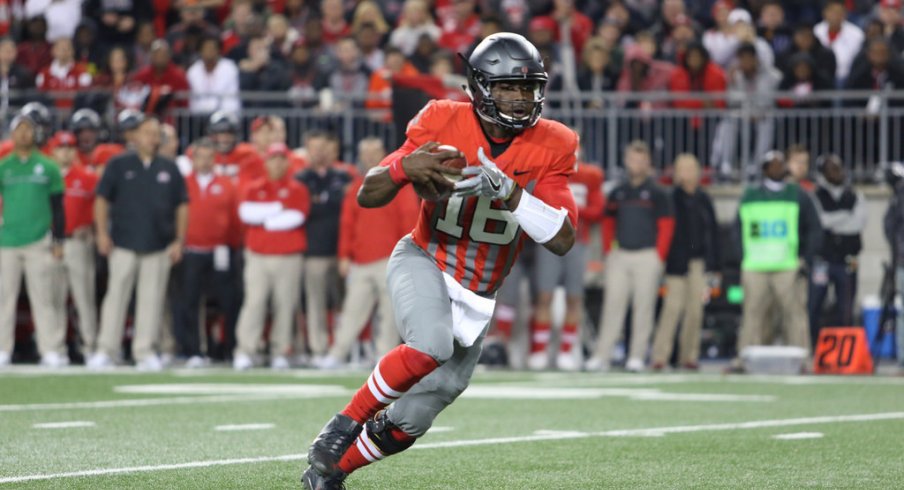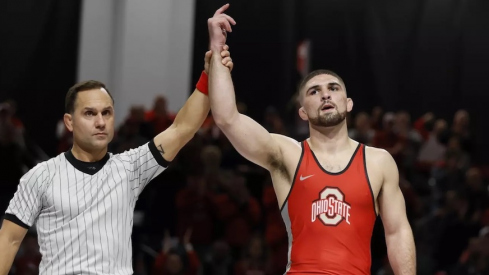Despite not living up to championship expectations recently, the Ohio State offense has evolved into one of the nation's best units in one particularly important area: 3rd down conversions.
While many fans and pundits have decried the lack of big plays and an inconsistent inside running game over the past month, Saturday night's blowout win over the Nebraska Cornhuskers showcased just how important such a skill can be. Though they only broke five plays for 20 yards or more on an evening in which the offense scored 48 points, the Buckeyes controlled the entire game while converting 11 of 15 3rd downs.
Led by an experienced quarterback in J.T. Barrett who never seems to be rattled in such situations, the Buckeyes have become the fifth-best offense in the nation in this particular category. While some may argue that a truly 'elite' offense should avoid these situations as much as possible, it's hard to argue that championships aren't won and lost on third down.
To back up that point, many recall the 2014 Buckeye offense as a powerhouse unit that dominated any and every opponent that came their way. In reality, though, the unit that would go on to roll through the first College Football Playoff was still working some things out in October. However, that championship team was excellent on the 'money down' all year, converting at the same clip as this 2016 squad:
| Year | # of Games | Attempts | Conversions | Conversion % | National Rank |
|---|---|---|---|---|---|
| 2012 | 12 | 158 | 67 | 42.41% | #48 |
| 2013 | 14 | 169 | 79 | 46.75% | #22 |
| 2014 | 15 | 198 | 103 | 52.02% | #3 |
| 2015 | 13 | 172 | 70 | 40.70% | #57 |
| 2016 | 9 | 139 | 73 | 52.52% | #5 |
Most importantly, that 2014 team seemed to find their stride in November, converting 60.61% of 3rd down attempts in the final month of the regular season. In the biggest matchup of that year, a November 8th trip to East Lansing to face fifth-ranked Michigan State, Barrett would lead his team to 10 conversions out of 14 on third down.
But, there is no magic formula to move the chains in these scenarios. Thanks to many of the tests faced by the Buckeye offense this fall, facing defensive game plans built around taking away any deep passes and forcing Barrett to dink-and-dunk his way down the field, play-caller Ed Warinner has found a comfort zone when needing to abandon the traditional run game and pick up a decent chunk of yardage.
While the Nebraska defense didn't lean as heavily on the 'Cover 3' look employed by many recent OSU opponents, playing a healthy amount of 'Quarters' coverage on early downs, the Huskers still leaned heavily on the three-deep coverage on third downs, especially when blitzing extra rushers. Warinner had expected such a look and had a flood concept to the weak side dialed up for the Buckeyes' first 3rd down of the night, leading to a big 20-yard completion to the intermediate route between two zone defenders:
The ability to mask concepts is crucial in these long-yardage situations, especially once the Huskers began running more man-to-man coverage as the game went on in an effort to focus on playmaker Curtis Samuel. Instead of allowing the Nebraska defense to key on Samuel with their best cover-defender, much the same way Ohio State cornerback Gareon Conley shadowed receiver Jordan Westerkamp on the other side of the ball, Warinner controlled the matchups by consistently calling for 'bunch' formations.
The key to play-calling in high-pressure situations is not just identifying the concepts that your team can execute in high-pressure situations, but by making them all look alike before the snap. Most of the route combinations Warinner called Saturday night weren't anything special, but were extremely effective thanks to their ability to open up natural separation for his most dangerous receiver.
After weeks of questions about the passing game, the Buckeyes seemed to find their groove thanks to concepts like these, which will help open up the base run game and deep, play-action passes in turn.
”I think we're spraying the ball all over the field,” co-offensive coordinator Tim Beck said Saturday night. “We're getting the ball out, swing routes to the back, we're getting the ball to the tight end more, which is creating some deep shot opportunities. We're doing a lot of different things. So now it's 'OK, who do you stop? Who do you cover?'”
Not all long-yardage play-calls are passes, though. Lost in the conversation about Ohio State's recent challenges when throwing the ball has been Barrett's exceptional ability to run it.
Running quarterbacks at the pro level often only get to showcase their talents when improvising, while many collegiate signal-callers only carry the ball in option situations if the defense keys on the running back. But Barrett has proven capable of excelling in both of those scenarios, as well as when run plays are directly designed for him to pick up yardage.
Even on 3rd-and-long, members of the Nebraska defense still followed the principles they'd practiced all week to take away the Buckeyes' zone running game. So, Warinner created a numbers advantage on the right side while holding a pair of unblocked defenders with the fake handoff to running back Mike Weber:
Runs like this one, or the 35-yard game-clinching rumble one week ago, were openly scorned by fans one year ago as three wideouts currently on NFL rosters lined up in the scarlet and gray. However, the balance that these runs bring to a play-sheet is immeasurable, as there simply aren't many defensive schemes that can rush the passer, maintain run-gap integrity, and defend 10-yard pass patterns all at once.
While the play-calling has been a major factor in the Buckeyes' success on third downs, the most important factor has undoubtedly been Barrett. On 36 third down carries this season, the junior has averaged 4.83 yards-per-carry and picked up 19 first downs, the highest total of any quarterback in America this fall. However, Barrett has remained just as effective throwing the ball, completing 63.1% of his passes for 454 yards, six touchdowns, and only one interception on 65 third down passing attempts.
Few stats can measure the Buckeye captain's exception pocket presence, decision-making, or demeanor in pressure situations, though. Just as he extended the play and trotted in for six to take the lead in Madison three weeks prior, Barrett escaped the collapsing pocket and found Terry McLaurin in the end zone for the first of his four touchdown passes against Nebraska. Those plays appear as an eight-yard run and a seven-yard pass in the box score but clearly meant so much more to his team's momentum and confidence when they occurred.
With Barrett at the helm and sitting just outside the playoff rankings with a giant matchup with an arch-rival looming, the Buckeye offense can begin feeling confident one again thanks to their ability to efficiently work their way down the field.
“We're starting to put it all together, and I'm glad it's happening now,” Meyer said after the win over Nebraska. “It is a little relief to know that right now I saw some explosiveness that we kind of have been lacking in some positions, and I think relief is probably the correct word, that we've all been waiting for that to happen.”



